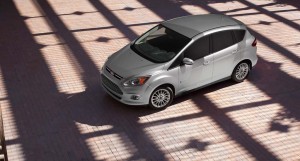Expect to see a lot about C-Max. That’s the Ford C-Max, to be more precise, the maker’s all-new people-mover and the first domestic hybrid that lifts a page from the Toyota Prius handbook by adopting a unique body style that won’t be shared with a standard gas powertrain.
Like the ever-popular Prius, meanwhile, Ford will offer both a “conventional” hybrid model as well as a plug-in version dubbed the Ford C-Max Energi. The maker will produce them at an upgraded plant in suburban Detroit alongside the new battery-electric version of the compact Focus.
Ford has been one of the most aggressive makers in challenging Toyota’s persistent lead in the hybrid segment but – like Honda which actually launched the first hybrid in the U.S. market, the original Insight – Ford has so far been unable to crack Toyota’s lead. The Prius currently accounts for more than half of all U.S. gas-electric vehicle sales, a lead that has grown with the creation of a so-called “Prius family” of hybrids.
Prius has become the “Kleenex of hybrids,” suggested Amy Machesney, the program manager for C-Max at a session revealing the new Ford advertising campaign. As with other recent models, Ford will be shifting a sizable chunk of its resources to non-traditional – meaning non-TV and print – marketing.
That includes a special C-Max website that offers a direct comparison between the two product lines, suggesting Ford believes it can deliver an advantage in terms of such selling points as interior space and range. The C-Max, in fact, most directly goes up against the largest member of the Prius family, the Prius V.
“It’s a direct comparison. Prius is so swell understood by customers. Toyota has done such a good job with hybrids. So it makes sense for us to compare C-Max to Prius,” explained Jim Farley, Ford’s global marketing chief – and a long-time Toyota employee before moving to Detroit in 2007 at the request of Ford’s then-new CEO Alan Mulally.
Machesney said she does not expect to come anywhere near Toyota’s hybrid volume. The Prius alone has accounted for about 51% of U.S. gas-electric volume this year while Ford is now down to barely 4%. That’s actually less than half the 9.5% the U.S. maker held a year ago but that was before Ford launched a new version of its Escape crossover, the 2013 version no longer offering a hybrid driveline.
Toyota is without question the most aggressive maker in terms of battery power, primarily in the hybrid segment. It recently restated a promise by President Akio Toyoda to offer a gas-electric powertrain option in virtually every model in its line-up. In fact, Toyota recently entered into a joint venture with Ford to develop hybrid drive systems for big SUVs and pickups that might eventually used in both of their full-size truck lines.
But Ford is increasingly pushing into the green space and will have as many as six different advanced battery models – such as the Focus Electric and C-Max and Fusion Energi plug-ins on the road soon. It will also have a number of conventional hybrids.
It has announced plans to invest $135 million in the Advanced Electrification Center at its engineering campus in Dearborn, Michigan to help develop future products and eventually expects to employ 1,000 engineers in that effort.
Notably, Ford recently began producing its own electric drive systems – its equivalent of the Prius Synergy Drive technology. It contends that by switching to in-house development it has been able to come up with a smaller, lighter and more fuel-efficient alternative as demonstrated with the new Ford Fusion Hybrid. The Detroit maker is heavily promoting the fact that the 2013 Fusion will have an 8 mpg highway mileage advantage over its direct Toyota rival, the Camry Hybrid, and 4 mpg in the city.
The $26,000 Ford C-Max began to reach showrooms last month, the maker ringing up about 1,000 sales so far. The C-Max Energi will begin sale in the coming weeks at a price of $34,000. But because it will have a 20-mile range on battery power it will qualify for a $3,750 federal tax credit – the same subsidy as the Toyota Prius Plug-in.


Well, I’ll be lucky if this gets printed as it seems UNLESS you are saying 100% positive about the American makers so with stating that I will have to work this post carefully.
The Prius alone has accounted for about 51% of U.S. gas-electric volume this year while Ford is now down to barely 4%. Ford can think this will knock the prius oof but 51% to 4 % of the market currently ????
This is not going to happen over night. May the best manufacturer win.
Hi, IS,
I’d hope to disagree with you and stress this site is NOT about saying nice things about American makers.
I think if you go back and re-read this story we made it clear that Prius dominates the market — something we have pointed out repeatedly on TheDetroitBureau.com — in fact, with the expanded Prius “family,” the lead has widened. The story clearly notes that Ford’s share FELL from 9.5% last year to barely 4% after dropping the Escape Hybrid.
Beyond that, we can only hope that the best maker wins. But that raises a question: will Ford be able to gain traction with a Fusion Hybrid delivering significantly better mileage than a Camry Hybrid (up to +8 mpg)? Or will the market perception simply continue to drive buyers to Toyota just, well, just because? We haven’t had a chance to drive the new Fusion Hybrid to the point we’re comfortable making a full comparison but the numbers alone should open eyes in a competitive market. Whether Ford can overcome the Toyota image is another matter.
Paul A. Eisenstein
Publisher, TheDetroitBureau.com